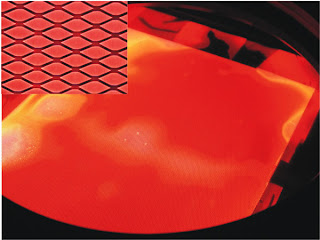Light and Light Sources gives an introduction to the working principles of high-intensity discharge (HID) lamps and points out challenges and problems associated with the development and operation of HID lamps. The state-of-the-art in electrode and plasma diagnostics as well as numerical methods used for the understanding of HID lamps are described. This volume addresses students as well as scientists and researchers at universities and in industry. | CHAMPAIGN, Ill. — Researchers at the University of Illinois are developing panels of microcavity plasma lamps that may soon brighten people’s lives. The thin, lightweight panels could be used for residential and commercial lighting, and for certain types of biomedical applications. “Built of aluminum foil, sapphire and small amounts of gas, the panels are less than 1 millimeter thick, and can hang on a wall like picture frames,” said Gary Eden, a professor of electrical and computer engineering at the U. of I., and corresponding author of a paper describing the microcavity plasma lamps in the June issue of the Journal of Physics D: Applied Physics. |
| Photograph of an aluminum foil lamp having a radiating area of 225 square centimeters. The inset is a magnified view of several diamond-shapes microcavities. |  |
Like conventional fluorescent lights, microcavity plasma lamps are glow-discharges in which atoms of a gas are excited by electrons and radiate light. Unlike fluorescent lights, however, microcavity plasma lamps produce the plasma in microscopic pockets and require no ballast, reflector or heavy metal housing. The panels are lighter, brighter and more efficient than incandescent lights and are expected, with further engineering, to approach or surpass the efficiency of fluorescent lighting.
A plasma panel consists of a sandwich of two sheets of aluminum foil separated by a thin dielectric layer of clear aluminum oxide (sapphire). At the heart of each lamp is a small cavity, which penetrates the upper sheet of aluminum foil and the sapphire.
“Each lamp is approximately the diameter of a human hair,” said visiting research scientist Sung-Jin Park, lead author of the paper. “We can pack an array of more than 250,000 lamps into a single panel.”
Completing the panel assembly is a glass window 500 microns (0.5 millimeters) thick. The window’s inner surface is coated with a phosphor film 10 microns thick, bringing the overall thickness of the lamp structure to 800 microns.
Flat panels with radiating areas of more than 200 square centimeters have been fabricated, Park said. Depending upon the type of gas and phosphor used, uniform emissions of any color can be produced.
In the researchers’ preliminary plasma lamp experiments, values of the efficiency – known as luminous efficacy – of 15 lumens per watt were recorded. Values exceeding 30 lumens per watt are expected when the array design and microcavity phosphor geometry are optimized, Eden said. A typical incandescent light has an efficacy of 10 to 17 lumens per watt.
The researchers also demonstrated flexible plasma arrays sealed in polymeric packaging. These devices offer new opportunities in lighting, in which lightweight arrays can be mounted onto curved surfaces – on the insides of windshields, for example.
The flexible arrays also could be used as photo-therapeutic bandages to treat certain diseases – such as psoriasis – that can be driven into remission by narrow-spectrum ultraviolet light, Eden said.
With Eden and Park, co-authors of the paper are graduate students Andrew Price and Jason Readle, and undergraduate student Jekwon Yoon.
Funding was provided by the U.S. Air Force Office of Scientific Research and the Office of Naval Research.
Editor’s note: To reach Gary Eden, call 217-333-4157; e-mail: jgeden@uiuc.edu.
Contact: James E. Kloeppel kloeppel@uiuc.edu 217-244-1073 University of Illinois at Urbana-Champaign
News Bureau, University of Illinois at Urbana-Champaign, 807 South Wright Street, Suite 520 East, Champaign, Illinois 61820-6261, Telephone 217-333-1085, Fax 217-244-0161, E-mail news@uiuc.edu
Technorati Tags: nano or Nanotech and Nanotechnology or microcavity plasma lamps and photo-therapeutic bandages or University of Illinois at Urbana-Champaign and A sound way to turn heat into electricity or 4th of July World's Fair Fireworks V and G8 Summit Heiligendamm VIDEO
















No comments:
Post a Comment